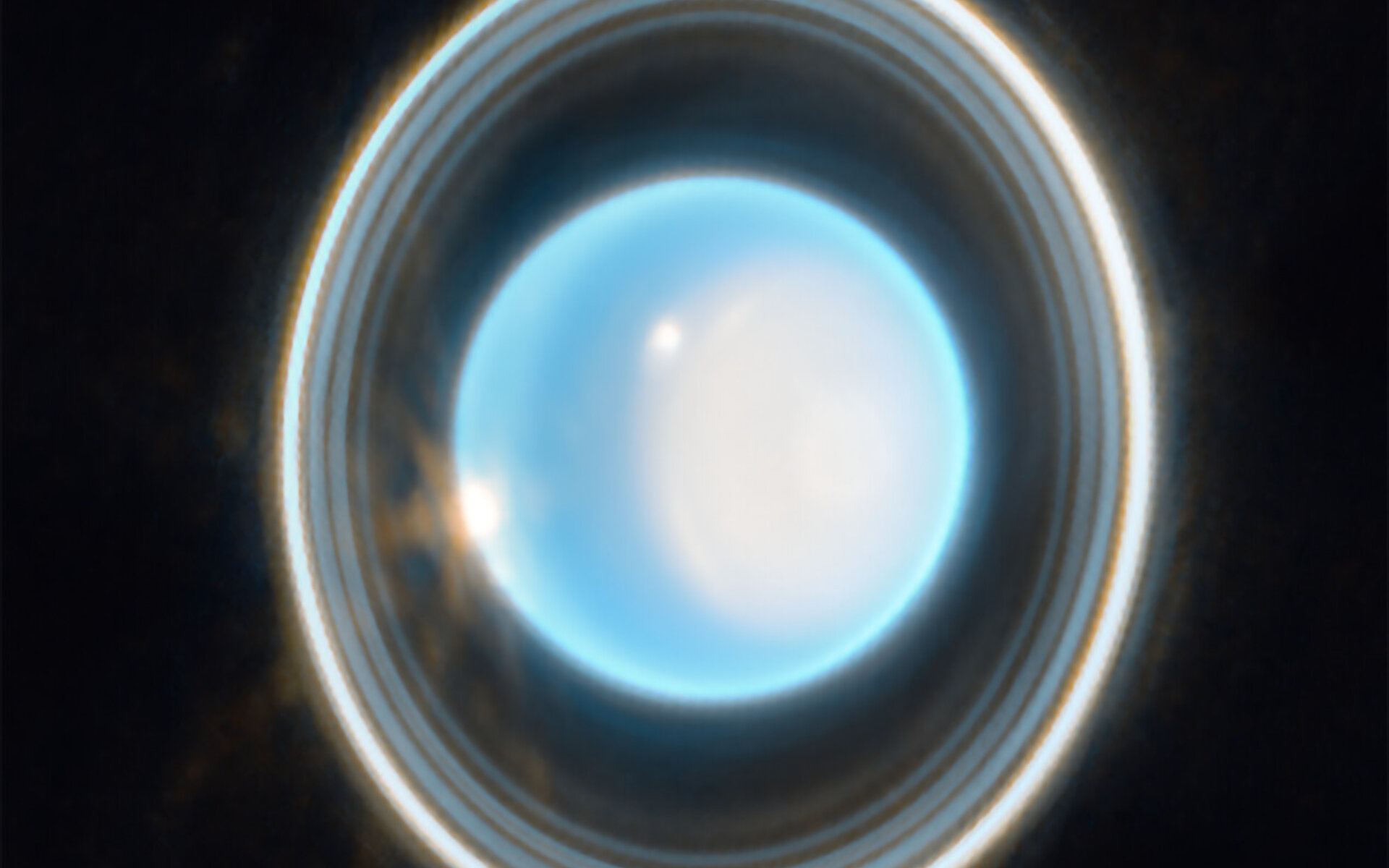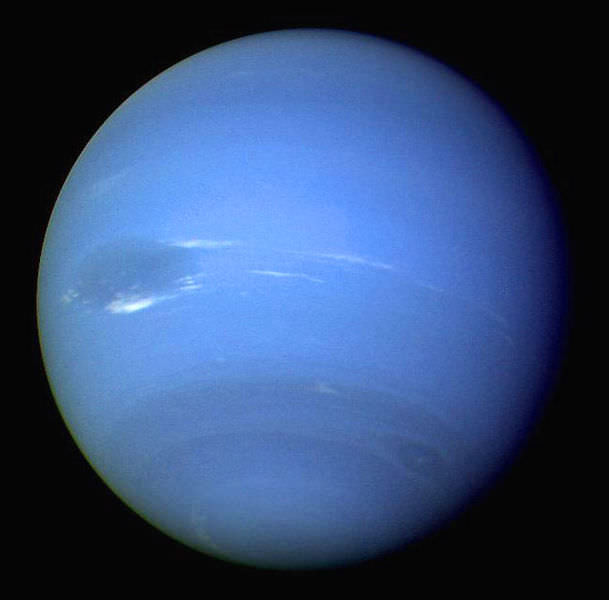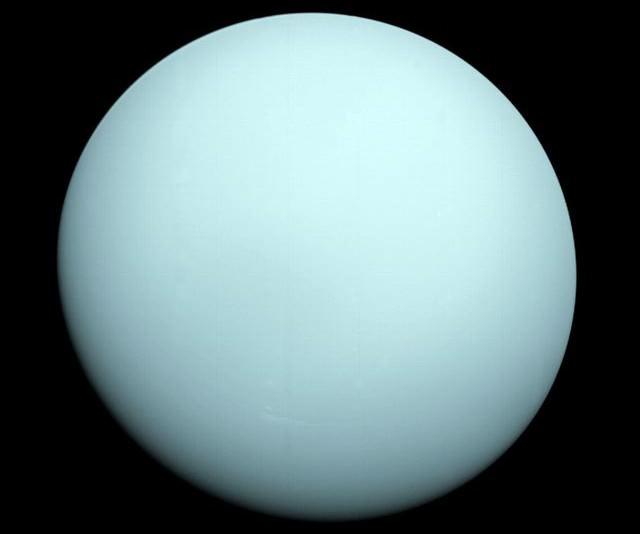It seems crazy that Uranus was discovered in 1781 yet here we are, in 2024 and we have only sent one spacecraft to explore Uranus. Voyager 2 is the only spacecraft to have given us close-up images of Uranus (and Neptune) but since their visit in 1986, we have not returned. There have of course been great images from the Hubble Space Telescope and from the James Webb Space Telescope but we still have lots to learn about them.
Continue reading “It’s Time to Go Back to Uranus. What Questions do Scientists Have About the Ice Giants?”Exploring the Ice Giants: Neptune and Uranus at Opposition for 2018

Have you seen the outer ice giant planets for yourself?
This week is a good time to check the most difficult of the major planets off of your life list, as Neptune reaches opposition for 2018 on Friday, September 7th at at ~18:00 Universal Time (UT)/2:00 PM EDT. And while it may not look like much more than a gray-blue dot at the eyepiece, the outermost ice giant world has a fascinating tale to tell. Continue reading “Exploring the Ice Giants: Neptune and Uranus at Opposition for 2018”
What is Neptune Made Of?
Since it’s discovery in the mid-19th century, Neptune has consistently been a planet of mystery. As the farthest planet from our Sun, it has only been visited by a single robotic mission. And there are still many unanswered questions about what kind of mechanics power its interior. Nevertheless, what we have learned about the planet in the course of the past few decades is considerable.
For example, thanks to the Voyager 2 probe and multiple surveys using Earth-based instruments, scientists have managed to gain a pretty good understanding of Neptune’s structure and composition. In addition to knowing what makes up its atmosphere, planetary models have also predicted what the interior of the planet looks like. So just what is Neptune made of?
Structure and Composition:
Neptune, like the rest of the gas giant planets in the Solar System, can be broken up into various layers. The composition of Neptune changes depending on which of these layers you’re looking at. The outermost layer of Neptune is the atmosphere, forming about 5-10% of the planet’s mass, and extending up to 20% of the way down to its core.
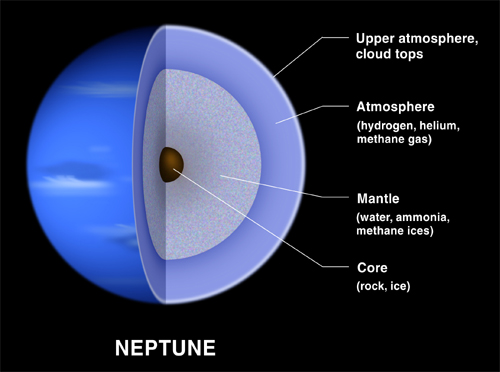
Beneath the atmosphere is the planet’s large mantle. This is a superheated liquid region where temperatures can reach as high as 2,000 to 5,000 K (1727 – 4727 °C; 3140 – 8540 °F). The mantle is equivalent to 10 – 15 Earth masses and is rich in water, ammonia and methane. This mixture is referred to as icy even though it is a hot, dense fluid, and is sometimes called a “water-ammonia ocean”.
Increasing concentrations of methane, ammonia and water are found in the lower regions of the atmosphere. Unlike Uranus, Neptune’s composition has a higher volume of ocean, whereas Uranus has a smaller mantle. Like the other gas/ice giants, Neptune is believed to have a solid core, the composition of which is still subject to guesswork. However, the theory that it is rocky and metal-rich is consistent with current theories of planet formation.
In accordance with these theories, the core of Neptune is composed of iron, nickel and silicates, with an interior model giving it a mass about 1.2 times that of Earth. The pressure at the center is estimated to be 7 Mbar (700 GPa), about twice as high as that at the center of Earth, and with temperatures as high as 5,400 K. At a depth of 7000 km, the conditions may be such that methane decomposes into diamond crystals that rain downwards like hailstones.
Due to its smaller size and higher concentrations of volatiles relative to Jupiter and Saturn, Neptune (much like Uranus) is often referred to as an “ice giant” – a subclass of a giant planet. Also like Uranus, Neptune’s internal structure is differentiated between a rocky core consisting of silicates and metals; a mantle consisting of water, ammonia and methane ices; and an atmosphere consisting of hydrogen, helium and methane gas.
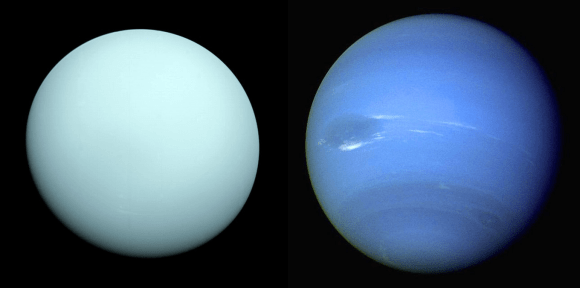
Neptune’s Atmosphere:
Neptune’s atmosphere forms about 5% to 10% of its mass and extends perhaps 10% to 20% of the way towards the core, where it reaches pressures of about 10 GPa – or about 100,000 times that of Earth’s atmosphere. At high altitudes, Neptune’s atmosphere is 80% hydrogen and 19% helium, with a trace amount of methane.
As with Uranus, this absorption of red light by the atmospheric methane is part of what gives Neptune its blue hue, although Neptune’s is darker and more vivid. Because Neptune’s atmospheric methane content is similar to that of Uranus, some unknown atmospheric constituent is thought to contribute to Neptune’s more intense coloring.
Neptune’s atmosphere is subdivided into two main regions: the lower troposphere (where temperature decreases with altitude), and the stratosphere (where temperature increases with altitude). The boundary between the two, the tropopause, lies at a pressure of 0.1 bars (10 kPa). The stratosphere then gives way to the thermosphere at a pressure lower than 10-5 to 10-4 microbars (1 to 10 Pa), which gradually transitions to the exosphere.
Neptune’s spectra suggest that its lower stratosphere is hazy due to condensation of products caused by the interaction of ultraviolet radiation and methane (i.e. photolysis), which produces compounds such as ethane and ethyne. The stratosphere is also home to trace amounts of carbon monoxide and hydrogen cyanide, which are responsible for Neptune’s stratosphere being warmer than that of Uranus.

For reasons that remain obscure, the planet’s thermosphere experiences unusually high temperatures of about 750 K (476.85 °C/890 °F). The planet is too far from the Sun for this heat to be generated by ultraviolet radiation, which means another heating mechanism is involved – which could be the atmosphere’s interaction with ion’s in the planet’s magnetic field, or gravity waves from the planet’s interior that dissipate in the atmosphere.
Because Neptune is not a solid body, its atmosphere undergoes differential rotation. The wide equatorial zone rotates with a period of about 18 hours, which is slower than the 16.1-hour rotation of the planet’s magnetic field. By contrast, the reverse is true for the polar regions where the rotation period is 12 hours.
This differential rotation is the most pronounced of any planet in the Solar System, and results in strong latitudinal wind shear and violent storms. The three most impressive were all spotted in 1989 by the Voyager 2 space probe, and then named based on their appearances.
The first to be spotted was a massive anticyclonic storm measuring 13,000 x 6,600 km and resembling the Great Red Spot of Jupiter. Known as the Great Dark Spot, this storm was not spotted five later (Nov. 2nd, 1994) when the Hubble Space Telescope looked for it. Instead, a new storm that was very similar in appearance was found in the planet’s northern hemisphere, suggesting that these storms have a shorter life span than Jupiter’s.

The Scooter is another storm, a white cloud group located farther south than the Great Dark Spot. This nickname first arose during the months leading up to the Voyager 2 encounter in 1989, when the cloud group was observed moving at speeds faster than the Great Dark Spot.
The Small Dark Spot, a southern cyclonic storm, was the second-most-intense storm observed during the 1989 encounter. It was initially completely dark; but as Voyager 2 approached the planet, a bright core developed and could be seen in most of the highest-resolution images.
Exploration:
The Voyager 2 probe is the only spacecraft to have ever visited Neptune. The spacecraft’s closest approach to the planet occurred on August 25th, 1989, which took place at a distance of 4,800 km (3,000 miles) above Neptune’s north pole. Because this was the last major planet the spacecraft could visit, it was decided to make a close flyby of the moon Triton – similar to what had been done for Voyager 1‘s encounter with Saturn and its moon Titan.
The spacecraft performed a near-encounter with the moon Nereid before it came to within 4,400 km of Neptune’s atmosphere on August 25th, then passed close to the planet’s largest moon Triton later the same day. The spacecraft verified the existence of a magnetic field surrounding the planet and discovered that the field was offset from the center and tilted in a manner similar to the field around Uranus.
Neptune’s rotation period was determined using measurements of radio emissions and Voyager 2 also showed that Neptune had a surprisingly active weather system. Six new moons were discovered during the flyby, and the planet was shown to have more than one ring.
While no missions to Neptune are currently being planned, some hypothetical missions have been suggested. For instance, a possible Flagship Mission has been envisioned by NASA to take place sometime during the late 2020s or early 2030s. Other proposals include a possible Cassini-Huygens-style “Neptune Orbiter with Probes”, which was suggested back in 2003.
Another, more recent proposal by NASA was for Argo – a flyby spacecraft that would be launched in 2019, which would visit Jupiter, Saturn, Neptune, and a Kuiper belt object. The focus would be on Neptune and its largest moon Triton, which would be investigated around 2029.
Given its distance from Earth, it is no secret why the Trans-Neptunian region remains mysterious to us. In the coming decades, several proposed missions are expected to travel there and explore its rich population of icy bodies and the giant planet for which it is named. From these studies, we are likely to learn a great deal about Neptune and the history of the Solar System.
We have written many interesting articles about Neptune on Universe Today. Here’s Who Discovered Neptune?, What is the Surface of Neptune Like?, What is the Surface Temperature of Neptune?, How Many Moons Does Neptune Have?, What’s the Atmosphere of Neptune Like?, What Color is Neptune?, The Orbit of Neptune: How Long is a Year on Neptune?
If you’d like more information on Neptune, take a look at Hubblesite’s News Releases about Neptune, and here’s a link to NASA’s Solar System Exploration Guide to Neptune.
We have recorded an entire episode of Astronomy Cast just about Neptune. You can listen to it here, Episode 63: Neptune.
Sources:
What is the Surface Temperature of Neptune?
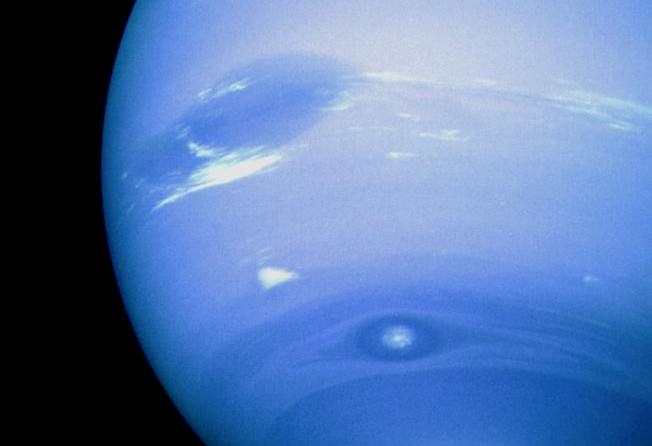
Our Solar System is a fascinating place. Between its eight planets and many dwarf planets, there are some serious differences in terms of orbit, composition, and temperature. Whereas conditions within the inner Solar System, where planets are terrestrial in nature, can get pretty hot, planets that orbit beyond the Frost Line – where it is cold enough that volatiles (i.e. water, ammonia, methane, CO and CO²) condense into solids – can get mighty cold!
It is in this environment that we find Neptune, the Solar System’s most distance (and hence most cold) planet. While this gas/ice giant has no “surface” to speak of, Earth-based research and flybys have been conducted that have managed to obtain accurate measurements of the temperature in the planet’s upper atmosphere. All told, the planet experiences temperatures that range from approximately 55 K (-218 °C; -360 °F) to 72 K (-200 °C; -328 °F), making it the coldest planet in the Solar System.
Orbital Characteristics:
Of all the planets in the Solar System, Neptune orbits the Sun at the greatest average distance. With a very minor eccentricity (0.0086), it orbits the Sun at an semi-major axis of approximately 30.11 AU (4,504,450,000,000 km), ranging from 29.81 AU (4.459 x 109 km) at perihelion and 30.33 AU (4.537 x 109 km) at aphelion.
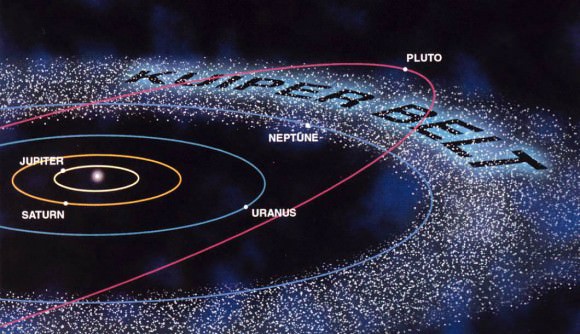
Neptune takes 16 hours 6 minutes and 36 seconds (0.6713 days) to complete a single sidereal rotation, and 164.8 Earth years to complete a single orbit around the Sun. This means that a single day lasts 67% as long on Neptune, whereas a year is the equivalent of approximately 60,190 Earth days (or 89,666 Neptunian days).
Because Neptune’s axial tilt (28.32°) is similar to that of Earth (~23°) and Mars (~25°), the planet experiences similar seasonal changes. Combined with its long orbital period, this means that the seasons last for forty Earth years. In addition, the planets axial tilt also leads to variations in the length of its day, as well as variations in temperature between the northern and southern hemispheres (see below).
“Surface” Temperature:
Due to their composition, determining a surface temperature on gas or ice giants (compared to terrestrial planets or moons) is technically impossible. As a result, astronomers have relied on measurements obtained at altitudes where the atmospheric pressure is equal to 1 bar (or 100 kilo Pascals), the equivalent of air pressure here on Earth at sea level.

It is here on Neptune, just below the upper level clouds, that pressures reach between 1 and 5 bars (100 – 500 kPa). It is also at this level that temperatures reach their recorded high of 72 K (-201.15 °C; -330 °F). At this temperature, conditions are suitable for methane to condense, and clouds of ammonia and hydrogen sulfide are thought to form (which is what gives Neptune its characteristically dark cyan coloring).
But as with all gas and ice giants, temperatures vary on Neptune due to depth and pressure. In short, the deeper one goes into Neptune, the hotter it becomes. At its core, Neptune reaches temperatures of up to 7273 K (7000 °C; 12632 °F), which is comparable to the surface of the Sun. The huge temperature differences between Neptune’s center and its surface create huge wind storms, which can reach as high as 2,100 km/hour, making them the fastest in the Solar System.
Temperature Anomalies and Variations:
Whereas Neptune averages the coldest temperatures in the Solar System, a strange anomaly is the planet’s south pole. Here, it is 10 degrees K warmer than the rest of planet. This “hot spot” occurs because Neptune’s south pole is currently exposed to the Sun. As Neptune continues its journey around the Sun, the position of the poles will reverse. Then the northern pole will become the warmer one, and the south pole will cool down.
Neptune’s more varied weather when compared to Uranus is due in part to its higher internal heating, which is particularly perplexing for scientists. Despite the fact that Neptune is located over 50% further from the Sun than Uranus, and receives only 40% its amount of sunlight, the two planets’ surface temperatures are roughly equal.
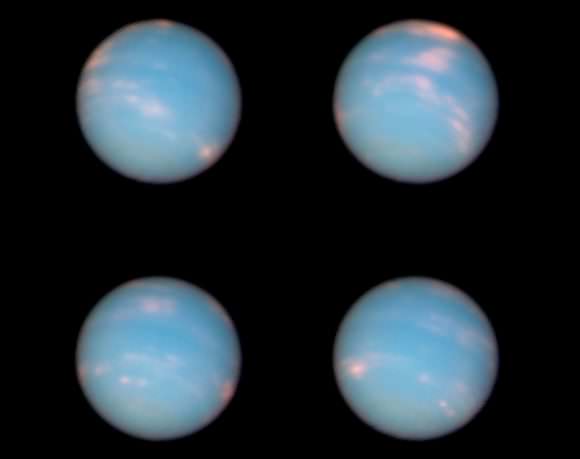
Deeper inside the layers of gas, the temperature rises steadily. This is consistent with Uranus, but oddly enough, the discrepancy is larger. Uranus only radiates 1.1 times as much energy as it receives from the Sun, whereas Neptune radiates about 2.61 times as much. Neptune is the farthest planet from the Sun, yet its internal energy is sufficient to drive the fastest planetary winds seen in the Solar System. The mechanism for this remains unknown.
And while temperatures on Pluto have been recorded as reaching lower – down to 33 K (-240 °C; -400 °F) – Pluto’s status as a dwarf planet mean that it is no longer in the same class as the others. As such, Neptune remains the coldest planet of the eight.
We have written many articles about Neptune here at Universe Today. Here’s The Gas (and Ice) Giant Neptune, What is the Surface of Neptune Like?, 10 Interesting Facts About Neptune, and The Rings of Neptune.
If you’d like more information on Neptune, take a look at Hubblesite’s News Releases about Neptune, and here’s a link to NASA’s Solar System Exploration Guide to Neptune.
We have recorded an entire episode of Astronomy Cast just about Neptune. You can listen to it here, Episode 63: Neptune.
What Are The Colors of the Planets?
When we look at beautiful images of the planets of our Solar System, it is important to note that we are looking at is not always accurate. Especially where their appearances are concerned, these representations can sometimes be altered or enhanced. This is a common practice, where filters or color enhancement is employed in order to make sure that the planets and their features are clear and discernible.
So what exactly do the planets of the Solar System look like when we take all the added tricks away? If we were to take pictures of them from space, minus the color enhancement, image touch-ups, and other methods designed to bring out their details, what would their true colors and appearances be? We already know that Earth resembles something of a blue marble, but what about the other ones?
What Is The Surface of Neptune Like?
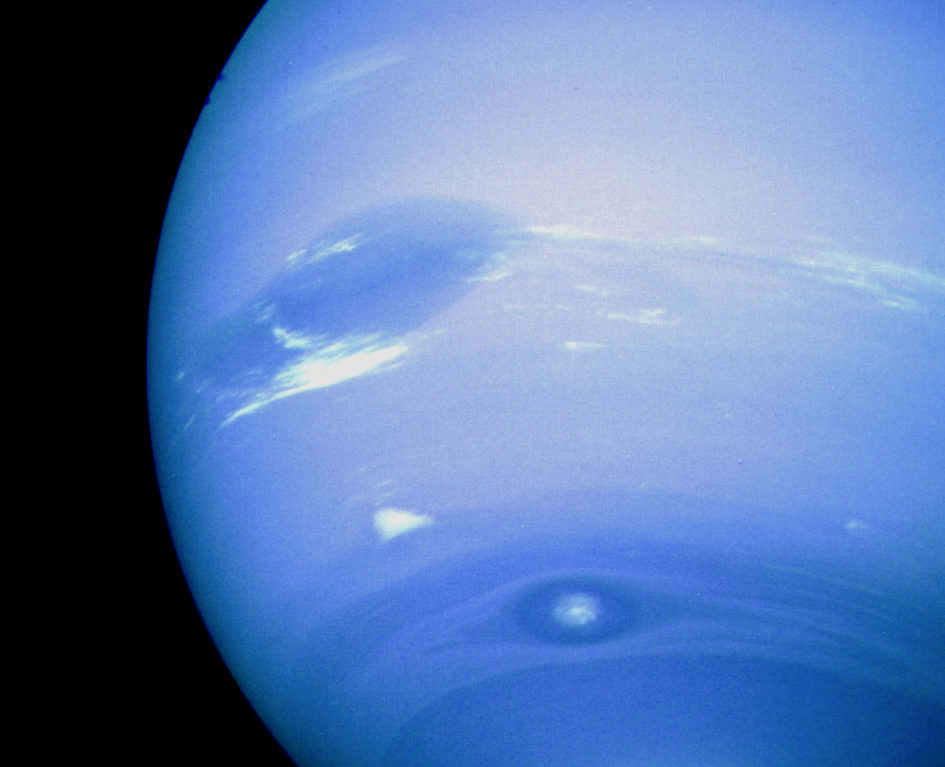
As a gas giant (or ice giant), Neptune has no solid surface. In fact, the blue-green disc we have all seen in photographs over the years is actually a bit of an illusion. What we see is actually the tops of some very deep gas clouds, which in turn give way to water and other melted ices that lie over an approximately Earth-size core made of silicate rock and a nickel-iron mix. If a person were to attempt to stand on Neptune, they would sink through the gaseous layers.
As they descended, they would experience increased temperatures and pressures until they finally touched down on the solid core itself. That being said, Neptune does have a surface of sorts, (as with the other gas and ice giants) which is defined by astronomers as being the point in the atmosphere where the pressure reaches one bar. Because of this, Neptune’s surface is one of the most active and dynamic places in entire the Solar System.
10 Interesting Facts About Neptune

Neptune is a truly fascinating world. But as it is, there is much that people don’t know about it. Perhaps it is because Neptune is the most distant planet from our Sun, or because so few exploratory missions have ventured that far out into our Solar System. But regardless of the reason, Neptune is a gas (and ice) giant that is full of wonder!
Below, we have compiled a list of 10 interesting facts about this planet. Some of them, you might already know. But others are sure to surprise and maybe even astound you. Enjoy!
Continue reading “10 Interesting Facts About Neptune”
The Planet Neptune
Neptune is the eight planet from our Sun, one of the four gas giants, and one of the four outer planets in our Solar System. Since the “demotion” of Pluto by the IAU to the status of a dwarf planet – and/or Plutoid and Kuiper Belt Object (KBO) – Neptune is now considered to be the farthest planet in our Solar System.
As one of the planets that cannot be seen with the naked eye, Neptune was not discovered until relatively recently. And given its distance, it has only been observed up close on one occasion – in 1989 by the Voyager 2 spaceprobe. Nevertheless, what we’ve come to know about this gas (and ice) giant in that time has taught us much about the outer Solar System and the history of its formation.
Discovery and Naming:
Neptune’s discovery did not take place until the 19th century, though there are indications that it was observed before long that. For instance, Galileo’s drawings from December 28th, 1612, and January 27th, 1613, contained plotted points which are now known to match up with the positions of Neptune on those dates. However, in both cases, Galileo appeared to have mistaken it for a star.
1821, French astronomer Alexis Bouvard published astronomical tables for the orbit of Uranus. Subsequent observations revealed substantial deviations from the tables, which led Bouvard to hypothesize that an unknown body was perturbing Uranus’ orbit through gravitational interaction.
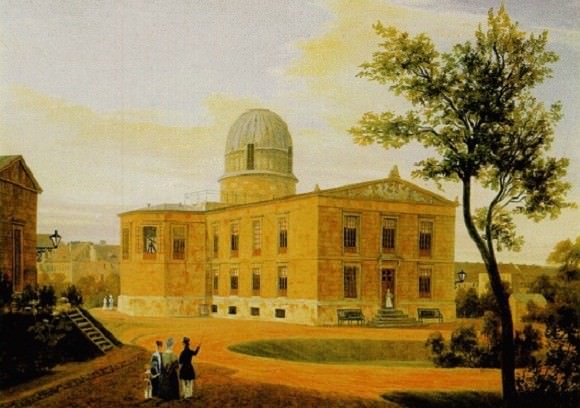
In 1843, English astronomer John Couch Adams began work on the orbit of Uranus using the data he had and produced several different estimates in the following years of the planet’s orbit. In 1845–46, Urbain Le Verrier, independently of Adams, developed his own calculations, which he shared with Johann Gottfried Galle of the Berlin Observatory. Galle confirmed the presence of a planet at the coordinates specified by Le Verrier on September 23rd, 1846.
The announcement of the discovery was met with controversy, as both Le Verrier and Adams claimed responsibility. Eventually, an international consensus emerged that both Le Verrier and Adams jointly deserved credit. However, a re-evaluation by historians in 1998 of the relevant historical documents led to the conclusion that Le Verrier was more directly responsible for the discovery and deserves the greater share of the credit.
Claiming the right of discovery, Le Verrier suggested the planet be named after himself, but this met with stiff resistance outside of France. He also suggested the name Neptune, which was gradually accepted by the international community. This was largely because it was consistent with the nomenclature of the other planets, all of which were named after deities from Greco-Roman mythology.
Neptune’s Size, Mass and Orbit:
With a mean radius of 24,622 ± 19 km, Neptune is the fourth largest planet in the Solar System and four times as large as Earth. But with a mass of 1.0243×1026 kg – which is roughly 17 times that of Earth – it is the third most massive, outranking Uranus. The planet has a very minor eccentricity of 0.0086, and orbits the Sun at a distance of 29.81 AU (4.459 x 109 km) at perihelion and 30.33 AU (4.537 x 109 km) at aphelion.
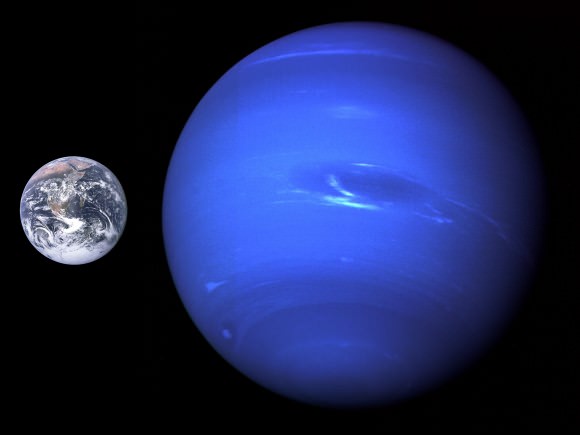
Neptune takes 16 h 6 min 36 s (0.6713 days) to complete a single sidereal rotation, and 164.8 Earth years to complete a single orbit around the Sun. This means that a single day lasts 67% as long on Neptune, whereas a year is the equivalent of approximately 60,190 Earth days (or 89,666 Neptunian days).
Because Neptune’s axial tilt (28.32°) is similar to that of Earth (~23°) and Mars (~25°), the planet experiences similar seasonal changes. Combined with its long orbital period, this means that the seasons last for forty Earth years. Also owing to its axial tilt being comparable to Earth’s is the fact that the variation in the length of its day over the course of the year is not any more extreme than it on Earth.
Neptune’s orbit also has a profound impact on the region directly beyond it, known as the Kuiper Belt (otherwise known as the “Trans-Neptunian Region”). Much in the same way that Jupiter’s gravity dominates the Asteroid Belt, shaping its structure, so Neptune’s gravity dominates the Kuiper Belt. Over the age of the Solar System, certain regions of the Kuiper belt became destabilised by Neptune’s gravity, creating gaps in the Kuiper belt’s structure.
There also exists orbits within these empty regions where objects can survive for the age of the Solar System. These resonances occur when Neptune’s orbital period is a precise fraction of that of the object – meaning they complete a fraction of an orbit for every orbit made by Neptune. The most heavily populated resonance in the Kuiper belt, with over 200 known objects, is the 2:3 resonance.
Objects in this resonance complete 2 orbits for every 3 of Neptune, and are known as plutinos because the largest of the known Kuiper belt objects, Pluto, is among them. Although Pluto crosses Neptune’s orbit regularly, the 2:3 resonance ensures they can never collide.
Neptune has a number of known trojan objects occupying both the Sun–Neptune L4 and L5 Lagrangian Points – regions of gravitational stability leading and trailing Neptune in its orbit. Some Neptune trojans are remarkably stable in their orbits, and are likely to have formed alongside Neptune rather than being captured.
Neptune’s Composition:
Due to its smaller size and higher concentrations of volatiles relative to Jupiter and Saturn, Neptune (much like Uranus) is often referred to as an “ice giant” – a subclass of a giant planet. Also like Uranus, Neptune’s internal structure is differentiated between a rocky core consisting of silicates and metals; a mantle consisting of water, ammonia and methane ices; and an atmosphere consisting of hydrogen, helium and methane gas.
The core of Neptune is composed of iron, nickel and silicates, with an interior model giving it a mass about 1.2 times that of Earth. The pressure at the center is estimated to be 7 Mbar (700 GPa), about twice as high as that at the center of Earth, and with temperatures as high as 5,400 K. At a depth of 7000 km, the conditions may be such that methane decomposes into diamond crystals that rain downwards like hailstones.
The mantle is equivalent to 10 – 15 Earth masses and is rich in water, ammonia and methane. This mixture is referred to as icy even though it is a hot, dense fluid, and is sometimes called a “water-ammonia ocean”. Meanwhile, the atmosphere forms about 5% to 10% of its mass and extends perhaps 10% to 20% of the way towards the core, where it reaches pressures of about 10 GPa – or about 100,000 times that of Earth’s atmosphere.

Increasing concentrations of methane, ammonia and water are found in the lower regions of the atmosphere. Unlike Uranus, Neptune’s composition has a higher volume of ocean, whereas Uranus has a smaller mantle.
Neptune’s Atmosphere:
At high altitudes, Neptune’s atmosphere is 80% hydrogen and 19% helium, with a trace amount of methane. As with Uranus, this absorption of red light by the atmospheric methane is part of what gives Neptune its blue hue, although Neptune’s is darker and more vivid. Because Neptune’s atmospheric methane content is similar to that of Uranus, some unknown atmospheric constituent is thought to contribute to Neptune’s more intense coloring.
Neptune’s atmosphere is subdivided into two main regions: the lower troposphere (where temperature decreases with altitude), and the stratosphere (where temperature increases with altitude). The boundary between the two, the tropopause, lies at a pressure of 0.1 bars (10 kPa). The stratosphere then gives way to the thermosphere at a pressure lower than 10-5 to 10-4 microbars (1 to 10 Pa), which gradually transitions to the exosphere.
Neptune’s spectra suggest that its lower stratosphere is hazy due to condensation of products caused by the interaction of ultraviolet radiation and methane (i.e. photolysis), which produces compounds such as ethane and ethyne. The stratosphere is also home to trace amounts of carbon monoxide and hydrogen cyanide, which are responsible for Neptune’s stratosphere being warmer than that of Uranus.

For reasons that remain obscure, the planet’s thermosphere experiences unusually high temperatures of about 750 K (476.85 °C/890 °F). The planet is too far from the Sun for this heat to be generated by ultraviolet radiation, which means another heating mechanism is involved – which could be the atmosphere’s interaction with ion’s in the planet’s magnetic field, or gravity waves from the planet’s interior that dissipate in the atmosphere.
Because Neptune is not a solid body, its atmosphere undergoes differential rotation. The wide equatorial zone rotates with a period of about 18 hours, which is slower than the 16.1-hour rotation of the planet’s magnetic field. By contrast, the reverse is true for the polar regions where the rotation period is 12 hours.
This differential rotation is the most pronounced of any planet in the Solar System, and results in strong latitudinal wind shear and violent storms. The three most impressive were all spotted in 1989 by the Voyager 2 space probe, and then named based on their appearances.
The first to be spotted was a massive anticyclonic storm measuring 13,000 x 6,600 km and resembling the Great Red Spot of Jupiter. Known as the Great Dark Spot, this storm was not spotted five later (Nov. 2nd, 1994) when the Hubble Space Telescope looked for it. Instead, a new storm that was very similar in appearance was found in the planet’s northern hemisphere, suggesting that these storms have a shorter life span than Jupiter’s.

The Scooter is another storm, a white cloud group located farther south than the Great Dark Spot. This nickname first arose during the months leading up to the Voyager 2 encounter in 1989, when the cloud group was observed moving at speeds faster than the Great Dark Spot.
The Small Dark Spot, a southern cyclonic storm, was the second-most-intense storm observed during the 1989 encounter. It was initially completely dark; but as Voyager 2 approached the planet, a bright core developed and could be seen in most of the highest-resolution images.
Neptune’s Moons:
Neptune has 14 known satellites, all but one of which are named after Greek and Roman deities of the sea (S/2004 N 1 is currently unnamed). These moons are divided into two groups – the regular and irregular moons – based on their orbit and proximity to Neptune. Neptune’s Regular Moons – Naiad, Thalassa, Despina, Galatea, Larissa, S/2004 N 1, and Proteus – are those that are closest to the planet and which follow circular, prograde orbits that lie in the planet’s equatorial plane.
They range in distance from 48,227 km (Naiad) to 117,646 km (Proteus) from Neptune, and all but the outermost two (S/2004 N 1, and Proteus) orbit Neptune slower than its orbital period of 0.6713 days. Based on observational data and assumed densities, these moons range in size and mass from 96 x 60 x 52 km and 1.9 x 1017 kg (Naiad) to 436 x 416 x 402 km and 50.35 x 1017 kg (Proteus).
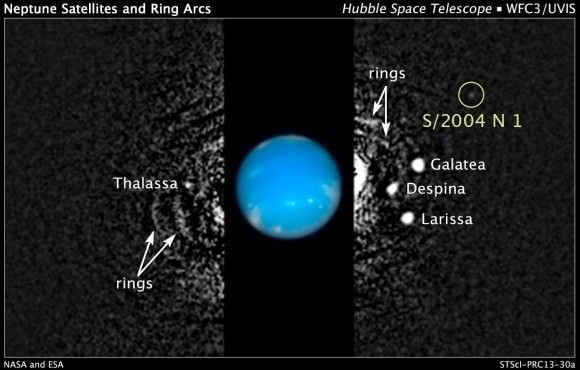
With the exception of Larissa and Proteus (which are largely rounded) all of Neptune’s inner moons are believed to be elongated in shape. Their spectra also indicates that they are made from water ice contaminated by some very dark material, probably organic compounds. In this respect, the inner Neptunian moons are similar to the inner moons of Uranus.
Neptune’s irregular moons consist of the planet’s remaining satellites (including Triton). They generally follow inclined eccentric and often retrograde orbits far from Neptune. The only exception is Triton, which orbits close to the planet, following a circular orbit, though retrograde and inclined.
In order of their distance from the planet, the irregular moons are Triton, Nereid, Halimede, Sao, Laomedeia, Neso and Psamathe – a group that includes both prograde and retrograde objects. With the exception of Triton and Nereid, Neptune’s irregular moons are similar to those of other giant planets and are believed to have been gravitationally captured by Neptune.
In terms of size and mass, the irregular moons are relatively consistent, ranging from approximately 40 km in diameter and 4 x 1016 kg in mass (Psamathe) to 62 km and 16 x 1016 kg for Halimede. Triton and Nereid are unusual irregular satellites and are thus treated separately from the other five irregular Neptunian moons. Between these two and the other irregular moons, four major differences have been noted.
First of all, they are the largest two known irregular moons in the Solar System. Triton itself is almost an order of magnitude larger than all other known irregular moons and comprises more than 99.5% of all the mass known to orbit Neptune (including the planet’s rings and thirteen other known moons).
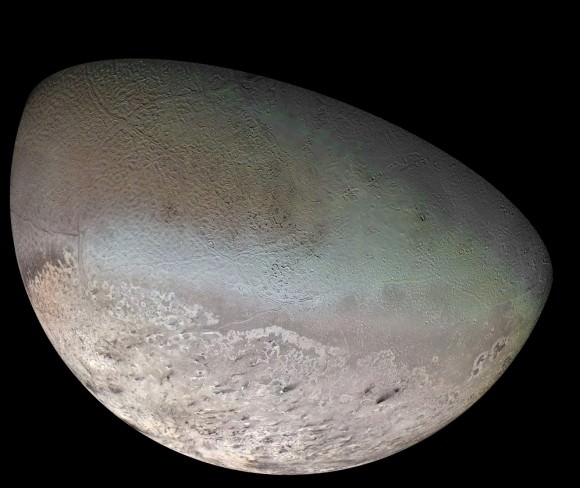
Secondly, they both have atypically small semi-major axes, with Triton’s being over an order of magnitude smaller than those of all other known irregular moons. Thirdly, they both have unusual orbital eccentricities: Nereid has one of the most eccentric orbits of any known irregular satellite, and Triton’s orbit is a nearly perfect circle. Finally, Nereid also has the lowest inclination of any known irregular satellite
With a mean diameter of around 2700 km and a mass of 214080 ± 520 x 1017 kg, Triton is the largest of Neptune’s moons, and the only one large enough to achieve hydrostatic equilibrium (i.e. is spherical in shape). At a distance of 354,759 km from Neptune, it also sits between the planet’s inner and outer moons.
Triton follows a retrograde and quasi-circular orbit, and is composed largely of nitrogen, methane, carbon dioxide and water ices. With a geometric albedo of more than 70% and a Bond albedo as high as 90%, it is also one of the brightest objects in the Solar System. The surface has a reddish tint, owning to the interaction of ultraviolet radiation and methane, causing tholins.
Triton is also one of the coldest moons in the Solar System, with surface temperature of about 38 K (-235.2 °C). However, owing to the moon being geologically active (which results in cryovolcanism) and surface temperature variations that cause sublimation, Triton is one of only two moons in the Solar System that has a substantial atmosphere. Much like it’s surface, this atmosphere is composed primarily of nitrogen with small amounts of methane and carbon monoxide, and with an estimated pressure of about 14 nanobar.
Triton has a relatively high density of about 2 g/cm3 indicating that rocks constitute about two thirds of its mass, and ices (mainly water ice) the remaining one third. There also may be a layer of liquid water deep inside Triton, forming a subterranean ocean. Surface features include the large southern polar cap, older cratered planes cross-cut by graben and scarps, as well as youthful features caused by endogenic resurfacing.
Because of its retrograde orbit and relative proximity to Neptune (closer than the Moon is to Earth), Triton is grouped with the planet’s irregular moons (see below). In addition, it is believed to be a captured object, possibly a dwarf planet that was once part of the Kuiper Belt. At the same time, these orbital characteristics are the reason why Triton experiences tidal deceleration. and will eventually spiral inward and collide with the planet in about 3.6 billion years.
Nereid is the third-largest moon of Neptune. It has a prograde but very eccentric orbit and is believed to be a former regular satellite that was scattered to its current orbit through gravitational interactions during Triton’s capture. Water ice has been spectroscopically detected on its surface. Nereid shows large, irregular variations in its visible magnitude, which are probably caused by forced precession or chaotic rotation combined with an elongated shape and bright or dark spots on the surface.
Neptune’s Ring System:
Neptune has five rings, all of which are named after astronomers who made important discoveries about the planet – Galle, Le Verrier, Lassell, Arago, and Adams. The rings are composed of at least 20% dust (with some containing as much as 70%) while the rest of the material consists of small rocks. The planet’s rings are difficult to see because they are dark and vary in density and size.
The Galle ring was named after Johann Gottfried Galle, the first person to see the planet using a telescope; and at 41,000–43,000 km, it is the nearest of Neptune’s rings. The La Verrier ring – which is very narrow at 113 km in width – is named after French astronomer Urbain Le Verrier, the planet’s co-founder.
At a distance of between 53,200 and 57,200 km from Neptune (giving it a width of 4,000 km) the Lassell ring is the widest of Neptune’s rings. This ring is named after William Lassell, the English astronomer who discovered Triton just seventeen days after Neptune was discovered. The Arago ring is 57,200 kilometers from the planet and less than 100 kilometers wide. This ring section is named after Francois Arago, Le Verrier’s mentor and the astronomer who played an active role in the dispute over who deserved credit for discovering Neptune.
The outer Adams ring was named after John Couch Adams, who is credited with the co-discovery of Neptune. Although the ring is narrow at only 35 kilometers wide, it is the most famous of the five due to its arcs. These arcs accord with areas in the ring system where the material of the rings is grouped together in a clump, and are the brightest and most easily observed parts of the ring system.
Although the Adams ring has five arcs, the three most famous are the “Liberty”, “Equality”, and “Fraternity” arcs. Scientists have been traditionally unable to explain the existence of these arcs because, according to the laws of motion, they should distribute the material uniformly throughout the rings. However, stronomers now estimate that the arcs are corralled into their current form by the gravitational effects of Galatea, which sits just inward from the ring.
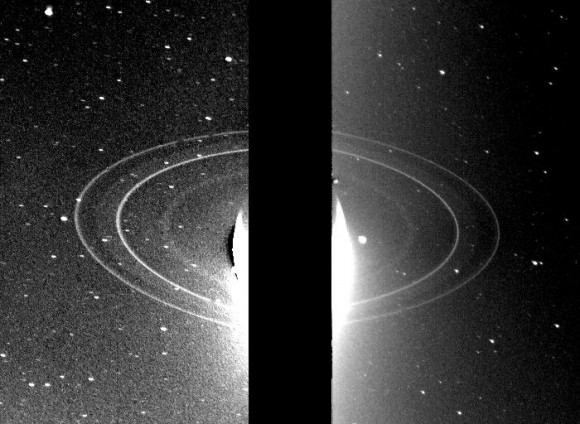
The rings of Neptune are very dark, and probably made of organic compounds that have been altered due to exposition to cosmic radiation. This is similar to the rings of Uranus, but very different to the icy rings around Saturn. They seem to contain a large quantity of micrometer-sized dust, similar in size to the particles in the rings of Jupiter.
It’s believed that the rings of Neptune are relatively young – much younger than the age of the Solar System, and much younger than the age of Uranus’ rings. Consistent with the theory that Triton was a KBO that was seized, by Neptune’s gravity, they are believed to be the result of a collision between some of the planet’s original moons.
Exploration:
The Voyager 2 probe is the only spacecraft to have ever visited Neptune. The spacecraft’s closest approach to the planet occurred on August 25th, 1989, which took place at a distance of 4,800 km (3,000 miles) above Neptune’s north pole. Because this was the last major planet the spacecraft could visit, it was decided to make a close flyby of the moon Triton – similar to what had been done for Voyager 1‘s encounter with Saturn and its moon Titan.
The spacecraft performed a near-encounter with the moon Nereid before it came to within 4,400 km of Neptune’s atmosphere on August 25th, then passed close to the planet’s largest moon Triton later the same day. The spacecraft verified the existence of a magnetic field surrounding the planet and discovered that the field was offset from the center and tilted in a manner similar to the field around Uranus.
Neptune’s rotation period was determined using measurements of radio emissions and Voyager 2 also showed that Neptune had a surprisingly active weather system. Six new moons were discovered during the flyby, and the planet was shown to have more than one ring.
While no missions to Neptune are currently being planned, some hypothetical missions have been suggested. For instance, a possible Flagship Mission has been envisioned by NASA to take place sometime during the late 2020s or early 2030s. Other proposals include a possible Cassini-Huygens-style “Neptune Orbiter with Probes”, which was suggested back in 2003.
Another, more recent proposal by NASA was for Argo – a flyby spacecraft that would be launched in 2019, which would visit Jupiter, Saturn, Neptune, and a Kuiper belt object. The focus would be on Neptune and its largest moon Triton, which would be investigated around 2029.
With its icy-blue color, liquid surface, and wavy weather patterns, Neptune was appropriately named after the Roman god of the sea. And given its distance from our planet, there is still a great deal that remains to be learned about it. In the coming decades, one can only hope that a mission to the outer Solar System and/or Kuiper Belt includes a flyby of Neptune.
We have many interesting articles about Neptune here at Universe Today. Below is a comprehensive list for your viewing (and possibly researching) pleasure!
Characteristics of Neptune:
- Neptune Fact Sheet
- How Big is Neptune?
- What is Neptune Made Of?
- Diameter of Neptune
- Density of Neptune
- Gravity on Neptune
- Mass of Neptune
- Axis Tilt of Neptune
- Size of Neptune
- Radius of Neptune
- Temperature of Neptune
- Neptune Compared to Earth
Position and Movement of Neptune:
- How Long is a Day on Neptune?
- How Far is Neptune from Earth?
- Orbit of Neptune
- How Long is a Year on Neptune?
- How Long Does it Take Neptune to Orbit the Sun?
- Neptune’s Distance from the Sun
Neptune’s Moon and Rings:
History of Neptune:
Neptune’s Surface and Structure:
The Planet Uranus
Uranus, which takes its name from the Greek God of the sky, is a gas giant and the seventh planet from our Sun. It is also the third largest planet in our Solar System, ranking behind Jupiter and Saturn. Like its fellow gas giants, it has many moons, a ring system, and is primarily composed of gases that are believed to surround a solid core.
Though it can be seen with the naked eye, the realization that Uranus is a planet was a relatively recent one. Though there are indications that it was spotted several times over the course of the past two thousands years, it was not until the 18th century that it was recognized for what it was. Since that time, the full-extent of the planet’s moons, ring system, and mysterious nature have come to be known.
Discovery and Naming:
Like the five classic planets – Mercury, Venus, Mars, Jupiter and Saturn – Uranus can be seen without the aid of a telescope. But due to its dimness and slow orbit, ancient astronomers believed it to be a star. The earliest known observation was performed by Hipparchos, who recorded it as a star in his star catalog in 128 BCE – observations which were later included in Ptolemy’s Almagest.
The earliest definite sighting of Uranus took place in 1690 when English astronomer John Flamsteed – the first Astronomer Royal – spotted it at least six times and cataloged it as a star (34 Tauri). The French astronomer Pierre Lemonnier also observed it at least twelve times between the years of 1750 and 1769.
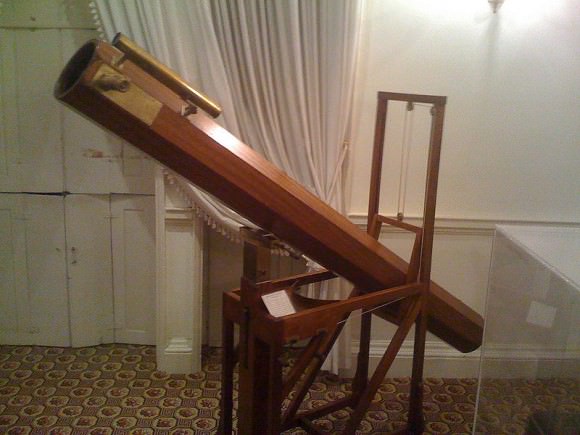
However, it was Sir William Herschel’s observation of Uranus on March 13th, 1781, that began the process of identifying it as a planet. At the time, he reported it as a comet sighting, but then engaged in a series of observations using a telescope of his own design to measure its position relative to the stars. When he reported on it to The Royal Society, he claimed it was a comet, but implicitly compared it to a planet.
Afterwards, several astronomers began to explore the possibility that Herschel’s “comet” was in fact a planet. These included Russian astronomer Anders Johan Lexell, who was the first to compute its nearly circular orbit, which led him to conclude it was a planet after all. Berlin astronomer Johann Elert Bode, a member of the “United Astronomical Society”, concurred with this after making similar observations of its orbit.
Soon, Uranus’ status as a planet became a scientific consensus, and by 1783, Herschel himself acknowledged this to the Royal Society. In recognition of his discovery, King George III of England gave Herschel an annual stipend of £200 on condition that he move to Windsor so that the Royal Family could look through his telescopes.
In honor of his new patron, William Herschel decided to name his discovery Georgium Sidus (“George’s Star” or “Georges Planet”). Outside of Britain, this name was not popular, and alternatives were soon proposed. These included French astronomer Jerome Lalande proposing to call it Hershel in honor of its discovery, and Swedish astronomer Erik Prosperin proposing the name Neptune.
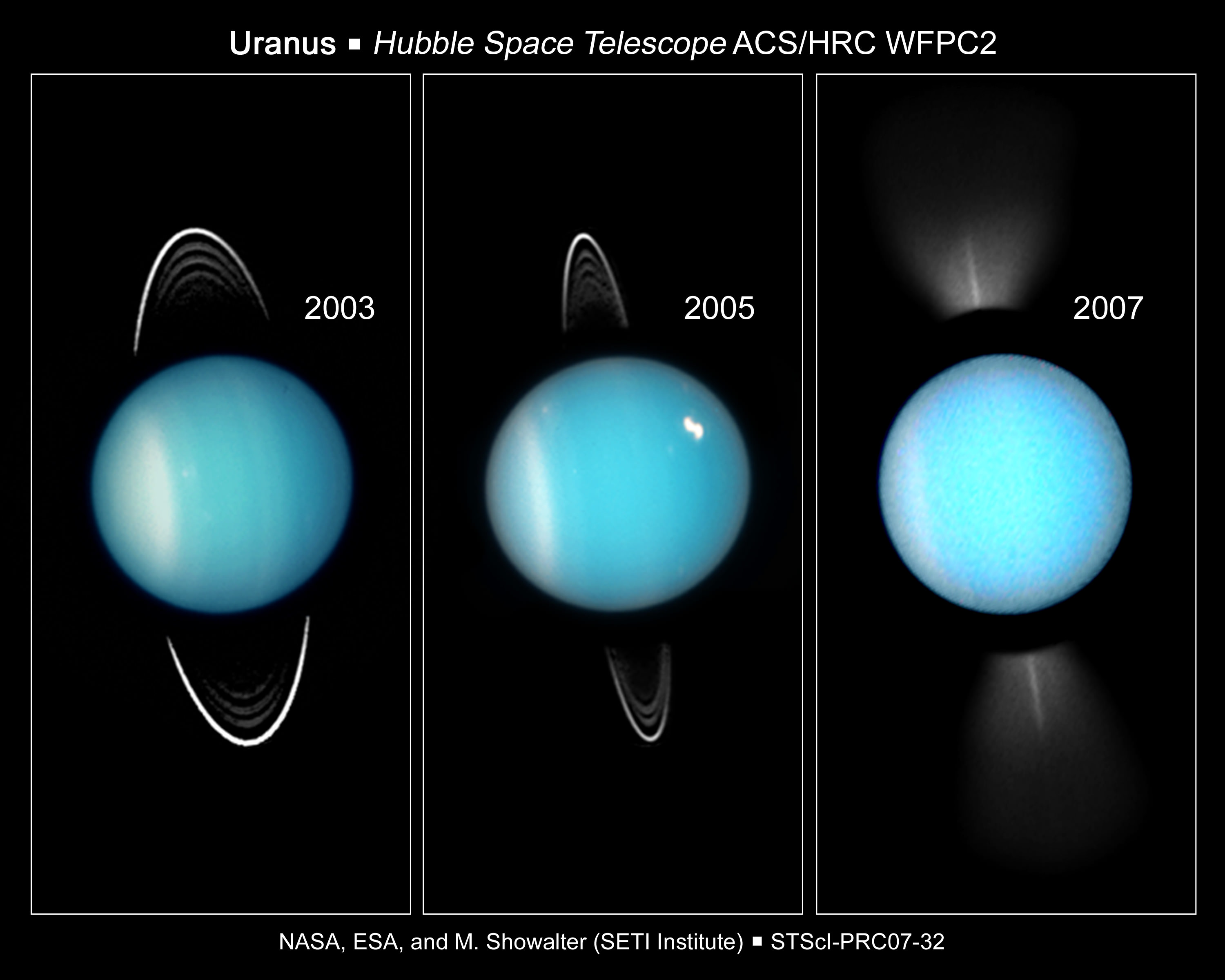
Johann Elert Bode proposed the name Uranus, the Latinized version of the Greek god of the sky, Ouranos. This name seemed appropriate, given that Saturn was named after the mythical father of Jupiter, so this new planet should be named after the mythical father of Saturn. Ultimately, Bode’s suggestion became the most widely used and became universal by 1850.
Uranus’ Size, Mass and Orbit:
With a mean radius of approximately 25,360 km, a volume of 6.833×1013 km3, and a mass of 8.68 × 1025 kg, Uranus is approximately 4 times the sizes of Earth and 63 times its volume. However, as a gas giant, its density (1.27 g/cm3) is significantly lower; hence, it is only 14.5 as massive as Earth. Its low density also means that while it is the third largest of the gas giants, it is the least massive (falling behind Neptune by 2.6 Earth masses).
The variation of Uranus’ distance from the Sun is also greater than that any other planet (not including dwarf planets or plutoids). Essentially, the gas giant’s distance from the Sun varies from 18.28 AU (2,735,118,100 km) at perihelion to 20.09 AU (3,006,224,700 km) at aphelion. At an average distance of 3 billion km from the Sun, it takes Uranus roughly 84 years (or 30,687 days) to complete a single orbit of the Sun.
The rotational period of the interior of Uranus is 17 hours, 14 minutes. As with all giant planets, its upper atmosphere experiences strong winds in the direction of rotation. At some latitudes, such as about 60 degrees south, visible features of the atmosphere move much faster, making a full rotation in as little as 14 hours.
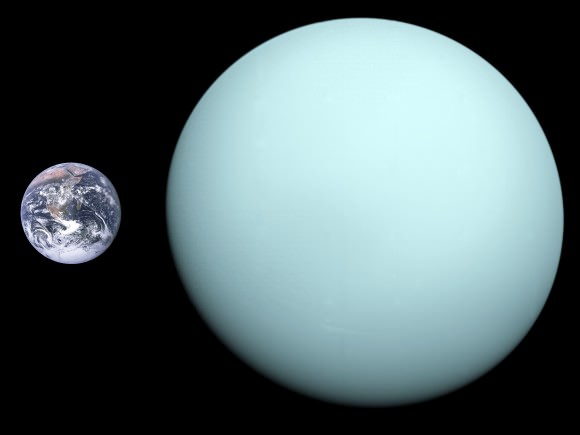
One unique feature of Uranus is that it rotates on its side. Whereas all of the Solar System’s planets are tilted on their axes to some degree, Uranus has the most extreme axial tilt of 98°. This leads to the radical seasons that the planet experiences, not to mention an unusual day-night cycle at the poles. At the equator, Uranus experiences normal days and nights; but at the poles, each experience 42 Earth years of day followed by 42 years of night.
Uranus’ Composition:
The standard model of Uranus’s structure is that it consists of three layers: a rocky (silicate/iron–nickel) core in the center, an icy mantle in the middle and an outer envelope of gaseous hydrogen and helium. Much like Jupiter and Saturn, hydrogen and helium account for the majority of the atmosphere – approximately 83% and 15% – but only a small portion of the planet’s overall mass (0.5 to 1.5 Earth masses).
The third most abundant element is methane ice (CH4), which accounts for 2.3% of its composition and which accounts for the planet’s aquamarine or cyan coloring. Trace amounts of various hydrocarbons are also found in the stratosphere of Uranus, which are thought to be produced from methane and ultraviolent radiation-induced photolysis. They include ethane (C2H6), acetylene (C2H2), methylacetylene (CH3C2H), and diacetylene (C2HC2H).
In addition, spectroscopy has uncovered carbon monoxide and carbon dioxide in Uranus’ upper atmosphere, as well as the presence icy clouds of water vapor and other volatiles, such as ammonia and hydrogen sulfide. Because of this, Uranus and Neptune are considered a distinct class of giant planet – known as “Ice Giants” – since they are composed mainly of heavier volatile substances.
The ice mantle is not in fact composed of ice in the conventional sense, but of a hot and dense fluid consisting of water, ammonia and other volatiles. This fluid, which has a high electrical conductivity, is sometimes called a water–ammonia ocean.

The core of Uranus is relatively small, with a mass of only 0.55 Earth masses and a radius that is less than 20% of the planet’s overall size. The mantle comprises its bulk, with around 13.4 Earth masses, and the upper atmosphere is relatively insubstantial, weighing about 0.5 Earth masses and extending for the last 20% of Uranus’s radius.
Uranus’s core density is estimated to be 9 g/cm3, with a pressure in the center of 8 million bars (800 GPa) and a temperature of about 5000 K (which is comparable to the surface of the Sun).
Uranus’ Atmosphere:
As with Earth, the atmosphere of Uranus is broken into layers, depending upon temperature and pressure. Like the other gas giants, the planet doesn’t have a firm surface, and scientists define the surface as the region where the atmospheric pressure exceeds one bar (the pressure found on Earth at sea level). Anything accessible to remote-sensing capability – which extends down to roughly 300 km below the 1 bar level – is also considered to be the atmosphere.
Using these references points, Uranus’ atmosphere can be divided into three layers. The first is the troposphere, between altitudes of -300 km below the surface and 50 km above it, where pressures range from 100 to 0.1 bar (10 MPa to 10 kPa). The second layer is the stratosphere, which reaches between 50 and 4000 km and experiences pressures between 0.1 and 10-10 bar (10 kPa to 10 µPa).
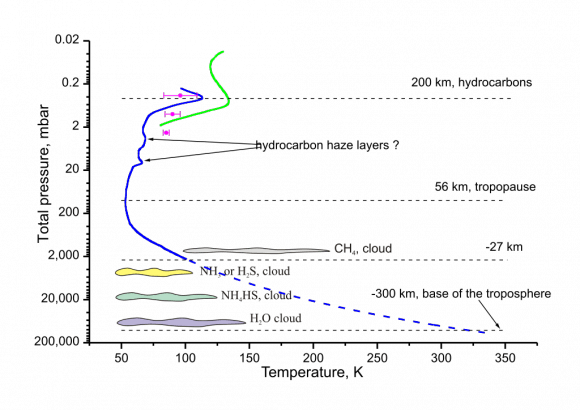
The troposphere is the densest layer in Uranus’ atmosphere. Here, the temperature ranges from 320 K (46.85 °C/116 °F) at the base (-300 km) to 53 K (-220 °C/-364 °F) at 50 km, with the upper region being the coldest in the solar system. The tropopause region is responsible for the vast majority of Uranus’s thermal infrared emissions, thus determining its effective temperature of 59.1 ± 0.3 K.
Within the troposphere are layers of clouds – water clouds at the lowest pressures, with ammonium hydrosulfide clouds above them. Ammonia and hydrogen sulfide clouds come next. Finally, thin methane clouds lay on the top.
In the stratosphere, temperatures range from 53 K (-220 °C/-364 °F) at the upper level to between 800 and 850 K (527 – 577 °C/980 – 1070 °F) at the base of the thermosphere, thanks largely to heating caused by solar radiation. The stratosphere contains ethane smog, which may contribute to the planet’s dull appearance. Acetylene and methane are also present, and these hazes help warm the stratosphere.
The outermost layer, the thermosphere and corona, extend from 4,000 km to as high as 50,000 km from the surface. This region has a uniform temperature of 800-850 (577 °C/1,070 °F), although scientists are unsure as to the reason. Because the distance to Uranus from the Sun is so great, the amount of heat coming from it is insufficient to generate such high temperatures.
Like Jupiter and Saturn, Uranus’s weather follows a similar pattern where systems are broken up into bands that rotate around the planet, which are driven by internal heat rising to the upper atmosphere. As a result, winds on Uranus can reach up to 900 km/h (560 mph), creating massive storms like the one spotted by the Hubble Space Telescope in 2012. Similar to Jupiter’s Great Red Spot, this “Dark Spot” was a giant cloud vortex that measured 1,700 kilometers by 3,000 kilometers (1,100 miles by 1,900 miles).
Uranus’ Moons:
Uranus has 27 known satellites, which are divided into the categories of larger moons, inner moons, and irregular moons (similar to other gas giants). The largest moons of Uranus are, in order of size, Miranda, Ariel, Umbriel, Oberon and Titania. These moons range in diameter and mass from 472 km and 6.7 × 1019 kg for Miranda to 1578 km and 3.5 × 1021 kg for Titania. Each of these moons is particularly dark, with low bond and geometric albedos. Ariel is the brightest while Umbriel is the darkest.
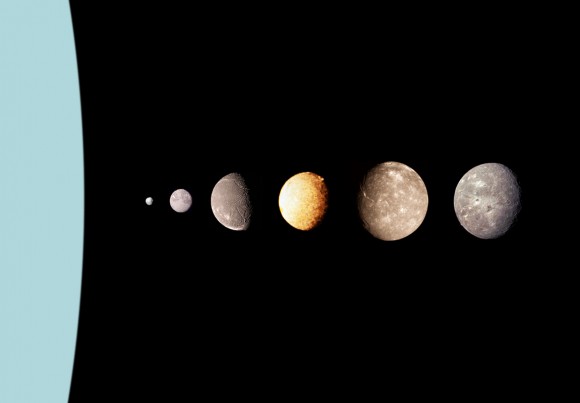
All of the large moons of Uranus are believed to have formed in the accretion disc, which existed around Uranus for some time after its formation, or resulted from the large impact suffered by Uranus early in its history. Each one is comprised of roughly equal amounts of rock and ice, except for Miranda which is made primarily of ice.
The ice component may include ammonia and carbon dioxide, while the rocky material is believed to be composed of carbonaceous material, including organic compounds (similar to asteroids and comets). Their compositions are believed to be differentiated, with an icy mantle surrounding a rocky core.
In the case of Titania and Oberon, it is believed that liquid water oceans may exist at the core/mantle boundary. Their surfaces are also heavily cratered; but in each case, endogenic resurfacing has led to a degree of renewal of their features. Ariel appears to have the youngest surface with the fewest impact craters while Umbriel appears to be the the oldest and most cratered.
The major moons of Uranus have no discernible atmosphere. Also, because of their orbit around Uranus, they experience extreme seasonal cycles. Because Uranus orbits the Sun almost on its side, and the large moons all orbit around Uranus’ equatorial plane, the northern and southern hemispheres experience prolonged periods of daytime and nighttime (42 years at a time).
As of 2008, Uranus is known to possess 13 inner moons whose orbits lie inside that of Miranda. They are, in order of distance from the planet: Cordelia, Ophelia, Bianca, Cressida, Desdemona, Juliet, Portia, Rosalind, Cupid, Belinda, Perdita, Puck and Mab. Consistent with the naming of the Uranus’ larger moons, all are named after characters from Shakespearean plays.
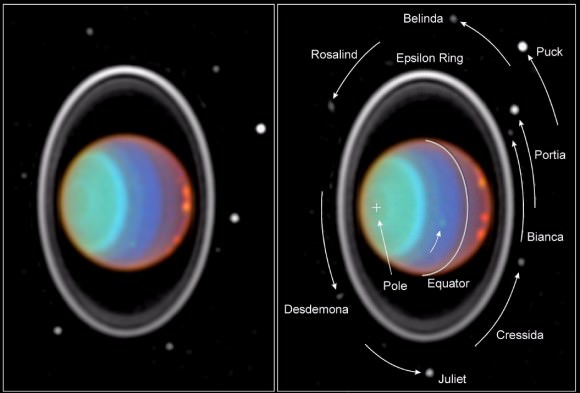
All inner moons are intimately connected to Uranus’ ring system, which probably resulted from the fragmentation of one or several small inner moons. Puck, at 162 km, is the largest of the inner moons of Uranus – and the only one imaged by Voyager 2 in any detail – while Puck and Mab are the two outermost inner satellites of Uranus.
All inner moons are dark objects. They are made of water ice contaminated with a dark material, which is probably organic materials processed by Uranus’ radiation. The system is also chaotic and apparently unstable. Computer simulations estimate that collisions may occur, particularly between Desdemona and Cressida or Juliet within the next 100 million years.
As of 2005, Uranus is also known to have nine irregular moons, which orbit it at a distance much greater than that of Oberon. All the irregular moons are probably captured objects that were trapped by Uranus soon after its formation. They are, in order of distance from Uranus: Francisco, Caliban, Stephano, Trincutio, Sycorax, Margaret, Prospero, Setebos, and Ferdinard (once again, named for characters in Shakespearean plays).
Uranus’s irregular moons range in size from about 150 km (Sycorax) to 18 km (Trinculo). With the exception of Margaret, all circle Uranus in retrograde orbits (meaning they orbit the planet in the opposite direction of its spin).
Uranus’ Ring System:
Like Saturn and Jupiter, Uranus has a ring system. However, these rings are composed of extremely dark particles which vary in size from micrometers to a fraction of a meter – hence why they are not nearly as discernible as Saturn’s. Thirteen distinct rings are presently known, the brightest being the epsilon ring. And with the exception of two very narrow ones, these rings usually measure a few kilometers in width.

The rings are probably quite young, and are not believed to have formed with Uranus. The matter in the rings may once have been part of a moon (or moons) that was shattered by high-speed impacts. From numerous pieces of debris that formed as a result of those impacts, only a few particles survived, in stable zones corresponding to the locations of the present rings.
The earliest known observations of the ring system took place on March 10th, 1977, by James L. Elliot, Edward W. Dunham, and Jessica Mink using the Kuiper Airborne Observatory. During an occultation of the star SAO 158687 (also known as HD 128598), they discerned five rings existing within a system around the planet, and observed four more later.
The rings were directly imaged when Voyager 2 passed Uranus in 1986, and the probe was able to detect two additional faint rings – bringing the number of observed rings to 11. In December 2005, the Hubble Space Telescope detected a pair of previously unknown rings, bringing the total to 13. The largest is located twice as far from Uranus as the previously known rings, hence why they are called the “outer” ring system.
In April 2006, images of the new rings from the Keck Observatory yielded the colors of the outer rings: the outermost is blue and the other one red. In contrast, Uranus’s inner rings appear grey. One hypothesis concerning the outer ring’s blue color is that it is composed of minute particles of water ice from the surface of Mab that are small enough to scatter blue light.
Exploration:
Uranus has only been visited once by any spacecraft: NASA’s Voyager 2 space probe, which flew past the planet in 1986. On January 24th, 1986, Voyager 2 passed within 81,500 km of the surface of the planet, sending back the only close up pictures ever taken of Uranus. Voyager 2 then continued on to make a close encounter with Neptune in 1989.
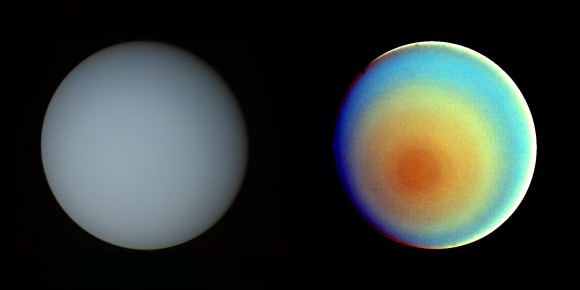
The possibility of sending the Cassini spacecraft from Saturn to Uranus was evaluated during a mission extension planning phase in 2009. However, this never came to fruition, as it would have taken about twenty years for Cassini to get to the Uranian system after departing Saturn.
In terms of future missions, multiple proposals have been made. For instance, a Uranus orbiter and probe was recommended by the 2013–2022 Planetary Science Decadal Survey published in 2011. This proposal envisaged a launch taking place between 2020–2023 and a 13-year cruise to Uranus. A New Frontiers Uranus Orbiter has been evaluated and was recommended in the study, The Case for a Uranus Orbiter. However, this mission is considered to be lower-priority than future missions to Mars and the Jovian System.
Scientists from the Mullard Space Science Laboratory in the United Kingdom have proposed a joint NASA-ESA mission to Uranus known as Uranus Pathfinder. This mission would involve launching a medium-class mission by 2022, and estimates place its cost at €470 million (~$525 million USD).
Another mission to Uranus, called Herschel Orbital Reconnaissance of the Uranian System (HORUS), was designed by the Applied Physics Laboratory of Johns Hopkins University. The proposal is for a nuclear-powered orbiter carrying a set of instruments, including an imaging camera, spectrometers and a magnetometer. The mission would launch in April 2021 and arrive at Uranus 17 years later.

In 2009, a team of planetary scientists from NASA’s Jet Propulsion Laboratory advanced possible designs for a solar-powered Uranus orbiter. The most favorable launch window for such a probe would be in August 2018, with arrival at Uranus in September 2030. The science package may include magnetometers, particle detectors and, possibly, an imaging camera.
Suffice it to say, Uranus is a hard target when it comes to exploration, and its distance has made the process of observing it recognizing it for what it was problematic in the past. And in the future, with most of our mission focused on exploring Mars, Europa, and Near-Earth Asteroids, the prospect of a mission to this region of the Solar System doesn’t seem very likely.
But budget environments change, as do scientific priorities. And with interest in the Kuiper Belt exploding thanks to the discovery of many Trans-Neptunian Objects in recent years, it is entirely possible that scientists will demand that a mission to the out solar system be mounted. If and when one occurs, it may be possible to have the probe swing by Uranus on its way out, gathering information and pictures to help advance our understanding of this “Ice Giant”.
We have many interesting articles about Uranus here at Universe Today. We hope you find what you are looking for in the list below:
- Atmosphere of Uranus
- Color of Uranus
- What is Uranus Made Of?
- How Long is a Day on Uranus?
- Density of Uranus
- Diameter of Uranus
- Discovery of Uranus
- How Far is Uranus from Earth?
- How Should You Pronounce Uranus?
- Gravity on Uranus
- Size of Uranus
- Tilt of Uranus
- Name of Uranus
- Mass of Uranus
- Uranus Pictures
- How Long is Year on Uranus?
- Orbit of Uranus
- Weather on Uranus
- Radius of Uranus
- Surface of Uranus
- Symbol for Uranus
- Core of Uranus
- 10 Interesting Facts About Uranus
- Temperature of Uranus
- Life on Uranus
- Uranus Rings
- Seasons on Uranus
- Water on Uranus
- Uranus Moons
- How Many Moons Does Uranus Have?
- Uranus and Neptune
- How Many Rings Does Uranus Have?
- How Long Does it Take Uranus to Orbit the Sun?
- Uranus Distance from the Sun
- Who Discovered Uranus?
- When was Uranus Discovered?
- Uranus Fact Sheet
- Moons of Uranus
- Oberon
- Titania
- Umbriel
- Who Discovered Uranus and When?
Ten Interesting Facts About Uranus
The gas (and ice) giant known as Uranus is a fascinating place. The seventh planet from out Sun, Uranus is the third-largest in terms of size, the fourth-largest in terms of mass, and one of the least dense objects in our Solar System. And interestingly enough, it is the only planet in the Solar System that takes it name from Greek (rather than Roman) mythology.
But these basic facts really only begin to scratch the surface. When you get right down to it, Uranus is chock full of interesting and surprising details – from its many moons, to its ring system, and the composition of its aqua atmosphere. Here are just ten things about this gas/ice giant, and we guarantee that at least one of them will surprise you.

